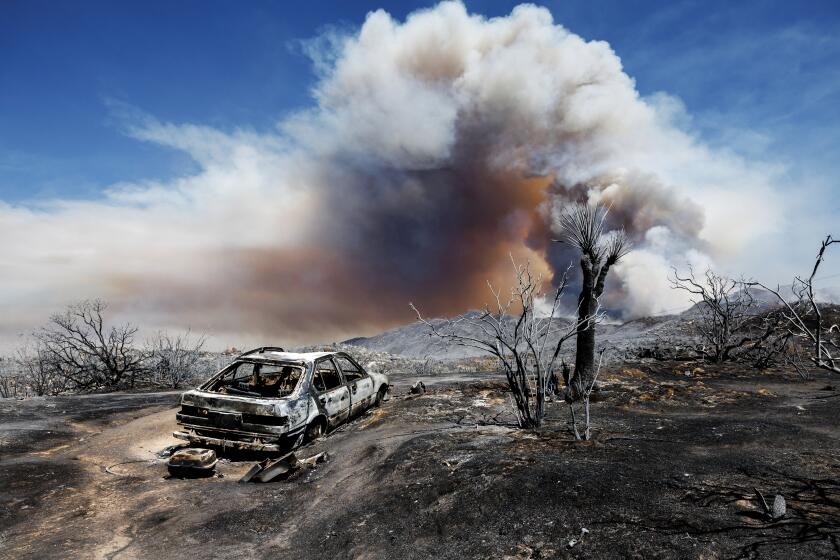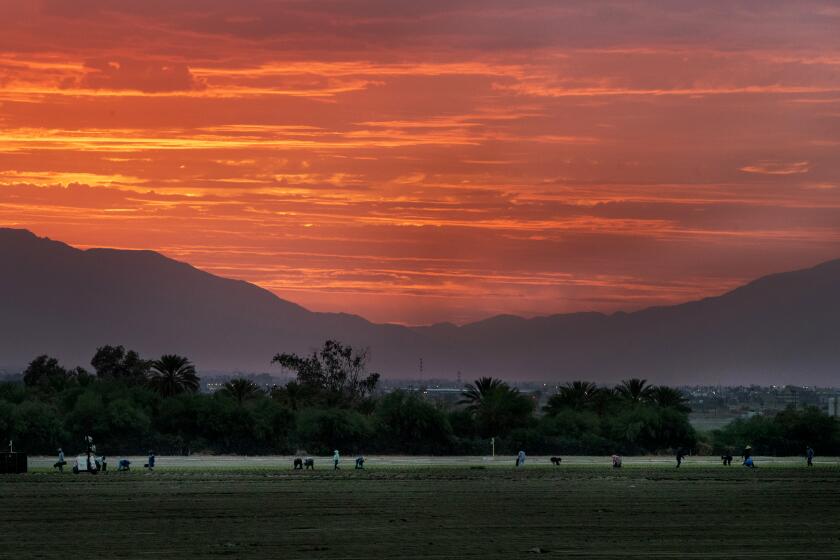
Heat-related mortality is on the rise in the United States, where high temperatures have caused or contributed to the deaths of more than 21,500 people since 1999, new research has found.
The last seven years in particular have been marked by a surge in heat-related deaths, including 2,325 deaths in 2023 — the planet’s hottest year on record, according to a study published Monday in the medical journal JAMA.
While previous research had not portrayed a clear trend in heat-related mortality in the U.S. — and in fact showed a slight downward trend from 1975 to 2018 — the latest paper is the first to demonstrate a clear uptick from 2016 to 2023. Researchers said the current trajectory is likely to continue due to climate change.
“The trend is what is really striking, and to me it justifies further investigation,” said Jeffrey Howard, the study’s lead author and an associate professor of public health at the University of Texas at San Antonio. “It justifies further investment in surveillance, better tools, and more effort at trying to understand what underlies these trends.”
The study analyzed death certificate data from the Centers for Disease Control and Prevention that listed “exposure to excessive natural heat,” “effects of heat and light,” or “environmental hyperthermia of a newborn” as either the underlying cause or a contributing cause of death, Howard said. (Data for 2023 are still provisional.)
Aggressive and impactful reporting on climate change, the environment, health and science.
However, prior research and reporting have found that heat deaths are chronically undercounted, in part because heat isn’t always listed on death certificates when it triggers other health issues, such as pulmonary disease.
What’s more, it’s not clear whether the recent uptick in heat-related deaths was solely due to rising temperatures, or whether health departments are also getting better at tracking and reporting heat as a factor, Howard said.
“There’s probably a little bit of both going on,” he said, adding that “the numbers are probably undercounted.”
California’s average temperature for July was the hottest on record since 1895, according to new data from NOAA.
Still, the findings underscore heat’s role as the deadliest of all climate hazards. Heat has killed more Americans on average over the last 30 years than hurricanes, floods and tornadoes combined, according to the National Weather Service.
The study also underscores the urgent need for local and national authorities to take action to prepare for more heat and heat-related deaths each year. Last month saw Earth’s two hottest days on record, July 22 and 23.
Howard said the vast majority of heat-related deaths occurred in California, Nevada, Texas and Arizona.
“Those four states account for a very large percentage of these,” he said.
Last year, Phoenix experienced 31 consecutive days of temperatures of 110 degrees or hotter, which county officials linked to a record 645 heat deaths in 2023.
“Local authorities in high-risk areas should consider investing in the expansion of access to hydration centers and public cooling centers or other buildings with air conditioning,” the study says.
Read all of our coverage about how California is neglecting the climate threat posed by extreme heat.
But cooling centers only go so far, according to Jonathan Parfrey, executive director of the nonprofit Climate Resolve. In fact, many sit empty during heat waves due to a lack of accessibility, locations or accommodating hours.
“The data is overwhelming that people don’t want to travel when there’s a heat wave — they want to stay put,” Parfrey said. Instead, it is important for neighbors to check on one another, and for city services to provide people with community-oriented resilience centers that offer more than just A/C or water.
Like Howard, Parfrey said the study almost certainly does not reflect the full scope of heat-related mortality. He also said he wished the researchers had been able to quantify how much of the trend was due to improvements in tracking and reporting of the causes of death.
The state of California, for example, has been working to roll out a syndromic surveillance system which will enable health officials to capture heat-related mortality data in real time, similar to what was done during the COVID-19 pandemic.
“That’s a huge improvement over what has previously taken place, because when we do these reports after heat waves, it’s always backward-looking, and it could be a year or two [before] somebody goes through the data,” he said. “The idea is that the California Department of Public Health realizes that this issue is never going to get attention unless the reporting on death is contemporaneous with the actual event.”
Parfrey recently participated in a panel with state and federal leaders about other ways California is working to protect residents from intensifying heat.
While heat is nothing new to the state, heat waves “are going to become more common, more intense and severe, and longer-lasting” due to climate change, said Wade Crowfoot, secretary of the California Natural Resources Agency.
In fact, the Golden State has gotten notably hotter over the last century.
In 1895, the average July temperature in California was 72.4 degrees. It increased about 4 degrees over the next 100 years, and then another 4 degrees over the next three decades, Crowfoot said. California’s average temperature this July — the state’s hottest month on record — was 81.7 degrees.
“We are living in record-breaking extreme temperatures,” Crowfoot said.
Future projections are similarly grim. Even under a best-case emissions scenario where humanity reduces its use of planet-warming fossil fuels, California will still experience a temperature increase of roughly 5.6 degrees by the end of the century — or nearly 9 degrees under a high-emission scenario, Crowfoot said.
A visit to Death Valley National Park has profound consequences for a veteran of extreme temperature. “I thought I knew heat.”
Gov. Gavin Newsom in 2022 unveiled California’s extreme heat action plan to increase the state’s resilience to soaring temperatures, which includes public awareness campaigns, infrastructure upgrades and nature-based solutions such as trees.
The state is also working to roll out CalHeatScore, a tool that will rank and classify heat waves similar to the way weather authorities categorize hurricanes.
“Extreme heat events are dangerous,” said Christina Curry, chief deputy director of the California Office of Emergency Services, during the panel. “They’re becoming more frequent and long-lasting, and they’re deadly. And what makes these particularly dangerous is that they’re invisible — they’re not like a fire or a flood where the public can see the danger and react to it.”
The California Division of Occupational Safety and Health, or Cal/OSHA, in July approved long-awaited heat standards for indoor workers, following a similar move for outdoor workers in 2006. However, a recent investigation by the Los Angeles Times and Capital & Main found that enforcement of the outdoor rules has been lagging.
What’s more, heat-related programs took a hit amid this year’s state budget cuts, including notable slashes to the extreme-heat action plan and reductions from urban greening programs.
With a global average temperature of 58.96 degrees, the year was nearly one-third of a degree warmer than the previous hottest year on record, according to officials.
Nationally, the Biden-Harris administration unveiled its own heat strategy earlier this month, which aims to improve the country’s preparation and response to high temperatures.
The Federal Emergency Management Agency has also begun rolling out heat-related programs, including its Building Resilient Infrastructure and Communities program, which provides funding for state and local areas in advance of disasters, according to Nick Shufro, acting assistant administrator with FEMA’s risk management directorate.
“My directorate is responsible for conducting assessments of risks ranging from natural risks to man-made and technological hazards, and we’re now starting, for the first time, to include extreme heat,” Shufro said during the panel. “So that is significant.”
However, heat experts have been urging FEMA to do more — including broadening its definition of “major disasters” to include extreme heat, which they say would open up more avenues of funding for cities and states to prepare for and respond to rising temperatures.
Howard, the study’s lead author, said it’s not only government agencies that should step up in response to rising heat mortality. Physicians, media outlets and community groups can also help spread awareness about the risk.
That’s partly why the researchers targeted JAMA, a medical journal, for publication of their findings, he said — noting that his own doctor in Texas has never mentioned the risk of extreme heat to him.
“There’s roles at various levels that can potentially be enhanced — both at the community level and also at the patient-physician level — to keep that awareness up and try to keep it top-of-mind,” he said. “Especially in the summer months.”












